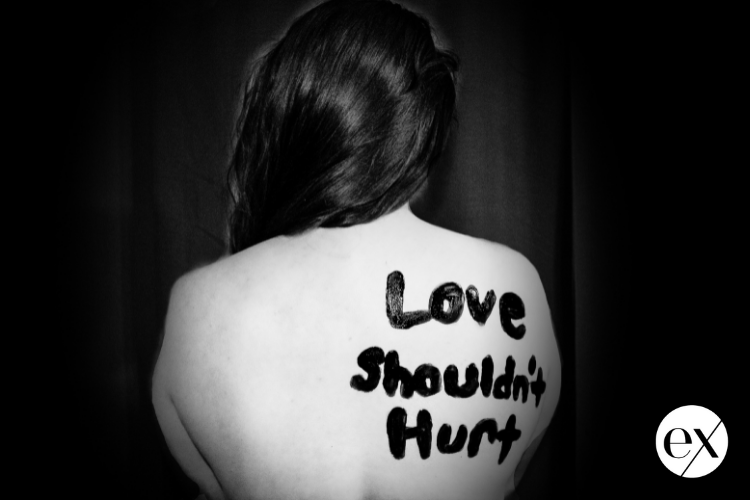
Kate Miller is an attorney, providing in-house counsel for the Center for Hope and Safety in northern New Jersey. The Center for Hope and Safety is a full-service shelter for victims of domestic violence. Kate has been an attorney for over ten years and began her career in the Baltimore City prosecutor’s office. When Kate moved to New Jersey, she started working at Partners for Women and Justice, a nonprofit law firm in New Jersey that serves victims of domestic violence. In 2016, she started working for the Center for Hope and Safety. She was drawn to the Center for Hope and Safety because it was a full-service domestic violence organization. This means that a client can receive shelter, counseling for her children, and legal assistance, all in one phone call.
Read on to learn about the Center for Hope and Safety and Kate’s work.
Which behaviors qualify as domestic violence?
Kate says any behavior used to gain power and control over another partner is domestic violence. Like most things in life, domestic violence is nuanced, and it does not look the same from one case to the next. It can be so many things and there are many parts of domestic violence. Your partner can be degrading and constantly insulting you. They can financially abuse you by not letting you control your own money. And of course, there can be physical and sexual abuse. Now with the internet, there can also be cyber abuse. Kate deals with clients where their partners post nude pictures of them on the internet. There are many different kinds of abuse, but if thing like this are happening in an intimate partner relationship, and they’re done as means for control over another person, that is domestic violence.
How can you tell if what you’re experiencing is domestic violence?
Well, first of all, there is no such thing as minor domestic violence. Everybody has a right to have a happy, loving relationship where there is mutual respect. As for warning signs, the essential element of domestic violence is power and control. You don’t need physical abuse for your partner’s actions to be classified as domestic violence. Your abuser does not need to lay a hand on you to control you. Manipulation and gaslighting are two examples of how a partner can abuse you emotionally. Kate has worked with clients who had to text their partner every time they left the house. She says these texts were not an act of love and consideration; they were mandatory status reports because their abuser needed to know where they were at all times. Any behavior that is controlling, harassing, and threatening is abuse. You should not feel afraid of your partner. Your partner is someone who you should feel is your equal. They should never have authority over you. Just because you may think your situation might not fit the exact criteria for domestic abuse does not minimize the reality of your experience. If you’re questioning your situation, don’t be afraid to ask for help.
Are children aware of domestic violence?
Kate regularly has clients who tell her that their children don’t realize what’s going on. However, children are aware of more than you think. Even though you might not believe that your children know, they can sense things. They’re also very susceptible to trauma at such a young age. Although they might not experience it directly, the abuse you endure trickles down to your kids. They get second-hand effects that can indirectly traumatize them.
Kids are very in tune with their parents and, in general, are very wise. People often say “we’re going to stay together for the kids,” when in reality, divorcing would be better for the kids. Children know your marriage is going sour before you consider separating. Staying with your partner, especially when they’re abusive, just adds another layer of stress for your children and yourself.
How has COVID-19 affected domestic violence cases?
Unfortunately, the pandemic has been attributed to an increase in cases of domestic violence. The spike in domestic violence reports results from people staying at home more often than they used to. The more time at home with an abusive partner, the higher the frequency of violent altercations. When people are home, they’re even more isolated. It’s a dangerous situation for victims of domestic abuse. Although there has been an increase in cases, Kate says they have not seen a rise in calls at the shelter. This is very troubling for Kate and the rest of her team at the Center for Hope and Safety. They are under the impression that many of their clients are lying low. These individuals don’t want to leave in this pandemic. It is a recipe for disaster.
How does someone connect with the Center for Hope and Safety in the first place?
Any client can call the National Domestic Violence Hotline. The number is 1-800-799-7233. They’ll connect you to a local program that can provide safety planning and determine what kind of service you need.
Once a woman comes into the shelter, what does in-house counseling mean for them?
Kate runs the legal department and providing in-house counseling means that the client won’t have to go elsewhere to find an attorney. Kate and her team also serve victims who are not in the Center for Hope and Safety safe house. If they get a phone call, they’ll complete a detailed intake to determine the client’s history and the case’s danger level so that they can get a better idea of it. Then Kate and her team can provide free representation to the client in their family law matters. They represent clients in restraining order cases, custody cases, support cases, immigration cases, and divorce cases.
It is tough to get free or low-cost legal services. Some centers have that available, and other times, they’ll link up with legal services, a legal aid bureau, or a nonprofit law firm.
If you’re not experiencing it yourself, but you think a friend might be going through it, what kind of signs should you look for? How do you even help?
Kate recommends looking out for warning signs that make you suspect their partner is controlling them. Anything that signifies your friend has a lack of autonomy and independence is a red flag. If you see that your friend cannot spend their own money, or if they say they can’t do certain things because their partner prohibits it, that’s a warning sign. These instances are not as visible as bruises, but they are tell-tale signs. If they’re saying anything that doesn’t sound right, take that as a sign.
Kate says the most important thing that you can do is be there for your friend because one of the things that abusers often do is isolate their victims. Abusers will attempt to isolate their partners by pushing away their friends or allowing them to only socialize when they are present. Slowly the abuser begins to erode all of their partner’s relationships so that when they want to make a phone call to a friend, they don’t have anyone. Just being there for them as a friend makes a difference. You can say,”‘I don’t really like the way they treat you, but I’m still going to be your friend.”
If you are having a conversation with someone, just being there, providing support and comfort is enormous. Keep in mind, your friend might still withhold info because a) they don’t know how to disclose it, or b) they don’t want to scare you off. Every instance of domestic violence is individualized. Your friend might also be in denial of their situation and attempt to defend their abusive partner. You don’t want to offend them and risk pushing them away. It’s a very tricky situation, so you want to come across as non-judgemental and make it clear that you’re approaching your friend from a place of concern. We all want to think of ourselves as strong, independent women. No one imagines domestic violence happening to them. Listening is the number one step, and then you could recommend they call the hotline. You could bring it up in a way that wouldn’t be embarrassing to them but, again, curate the conversation according to the individual.
How is the legal system protecting these women and children?
The legal system is doing its best to protect these women and children. The Center for Hope and Safety as an agency is lucky. Kate and her team have been very successful in their cases. Of course, not everybody wins, but the vast majority of the time, they can obtain a favorable outcome for their clients. Say that a client goes for criminal charges and their partner is found not guilty; it’s not like they have to go back to that situation. Because of other services that the Center for Hope and Safety and other domestic violence agencies offer, these clients can leave the situation, which is the safest thing of all. Kate says that this is a success no matter what the legal outcome.
Are there any cases with happy endings?
Kate represented one client who was the victim of abuse for about 20 years. She had called the police before and had her partner arrested. However, the client dropped the charges because she didn’t want him to lose his job since he supported the family. Then, an incident occurred where he strangled her, and she scratched him in self-defense. She did not have visible marks, but he had scratch marks on his face. Having learned from his previous experiences, her partner called the cops and had her arrested. He then got temporary custody of the kids. Kate and her team represented her in her restraining order trial. They were eventually able to win her back custody of the children. Kate and her team cooperated with the prosecutor’s office, were able to get the charges against her dropped, and then file charges against him. Now the client lives in her own house with the kids, and she’s doing great. The last they heard of her partner was that he was living in a halfway house. When Kate had first met this client, her shoulders were forward, she was wearing all black, and you could tell that she had been through a lot. Then Kate met her later on. She was wearing leopard print heels, her hair was done, and she was just holding herself differently. She had suffered through so much but had come so far and rediscovered her power.
Making that first step towards seeking help is the most challenging part because you’re acknowledging the abuse. One of Kate’s favorite things is when her clients tell her they didn’t realize how tired they were because of the constant conflict and self-monitoring. Once her clients are free, they find peace and finally can get a good night’s sleep. Getting out of an abusive relationship is possible. Do not underestimate the power of your resilience.
If anyone needs help, the National Hotline is 1-800-799-7233. If you’re in the New Jersey area, and you want to either seek help or volunteer with us, the Center for Hope and Safety website is www.hopeandsafetynj.org.
Leave a Comment
You must be logged in to post a comment.










